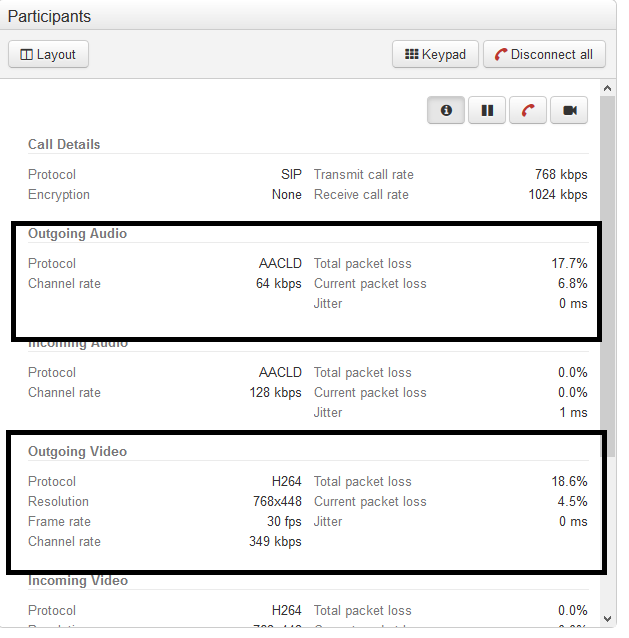Cisco SX20 Experiencing Packet Loss
We have a couple Cisco SX20 video conferencing units. They had up until this semester been working fine. This semester we are experiencing high packet loss outbound only (we can see and hear everyone fine but they get jitter and dropped audio). We have tried a bunch of things to fix the problem, but nothing seems to work. I am curious what usually causes this level of loss (anywhere from 6 to 20 % packet loss that goes up and down during the course of a call).
I have updated the firmware to the latest version 9.9.2, added QOS to the uplink port on the Cisco switch stack it connects to, and tired a multitude of things to get this working. Very frustrating for the distance learning they are trying to do. Any thoughts or suggestions would be appreciated.

I have updated the firmware to the latest version 9.9.2, added QOS to the uplink port on the Cisco switch stack it connects to, and tired a multitude of things to get this working. Very frustrating for the distance learning they are trying to do. Any thoughts or suggestions would be appreciated.

Mismatched mtus are likely, or a negociation issue with the upstream router. And obviously qos if you are using it.
ASKER
So I have QOS set up for our phones, but unsure about QOS for video conferencing might be another thing. Is that covered under the VOIP QOS or is there another set of commands I should be trying on the switches?
You should probably try disabling qos entirely unless you have a good reason to use it... or if your qos policy happens to be actually adequate, you are likely reaching the bandwidth limit so skipping packets in order to preserve bandwidth for other uses is the expected normal behavior
dig into the QOS settings :
it would seem sensible that you have reserved bandwidth for voice and internet and the switch actually does it's job by dropping less critical video-related packets when the bandwidth becomes scarce. in that case, you just need more bandwidth.
on the other hand, mis-configured QOS often end up making things worse by dropping packets all over the place and having the hosts retransmit and retry which makes matters worse
disabling qos could be viewed as an easy test : in the first case, your internet will likely start to slow down and vocal comms will start to break during busy hours with no improvement on the video feeds. in the second case, removing qos will actually improve the user experience. which does not mean you should not tackle the problem before it bites you harder.
it would seem sensible that you have reserved bandwidth for voice and internet and the switch actually does it's job by dropping less critical video-related packets when the bandwidth becomes scarce. in that case, you just need more bandwidth.
on the other hand, mis-configured QOS often end up making things worse by dropping packets all over the place and having the hosts retransmit and retry which makes matters worse
disabling qos could be viewed as an easy test : in the first case, your internet will likely start to slow down and vocal comms will start to break during busy hours with no improvement on the video feeds. in the second case, removing qos will actually improve the user experience. which does not mean you should not tackle the problem before it bites you harder.
ASKER
I am curious, is there special QOS for video conferencing? Or will the VOIP QOS i have set for our phones handle the traffic?
both are probably different. but only you can answer that ;)
qos can be configured with reservations, limitations, and a wealth of other tricks based on the vlan, the port in use...
what do you use ?
are you reaching your allocated bandwidth ?
does the packet loss drop to zero when there are fewer concurrent users ?
looking at your screenshot, it would seem you are aiming 360kbs and get 349 so somehow the equipment is probably dropping packets voluntarily because the channel rate cannot be maintained for that many concurrent users. but i have little to no experience with that equipment.
it also seems the packet loss is the same for audio. it just probably produces less visible results from a user's perspective. that would mean QOS might not be the issue after all
qos can be configured with reservations, limitations, and a wealth of other tricks based on the vlan, the port in use...
what do you use ?
are you reaching your allocated bandwidth ?
does the packet loss drop to zero when there are fewer concurrent users ?
looking at your screenshot, it would seem you are aiming 360kbs and get 349 so somehow the equipment is probably dropping packets voluntarily because the channel rate cannot be maintained for that many concurrent users. but i have little to no experience with that equipment.
it also seems the packet loss is the same for audio. it just probably produces less visible results from a user's perspective. that would mean QOS might not be the issue after all
ASKER CERTIFIED SOLUTION
membership
This solution is only available to members.
To access this solution, you must be a member of Experts Exchange.